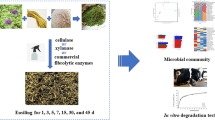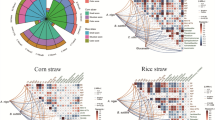Abstract
The objective of this study was to investigate the effects of cellulolytic lactic acid bacteria on the lignocellulose degradation, sugar profile and lactic acid fermentation of high-moisture alfalfa during anaerobic bioprocessing in low-temperature seasons. Last cut and low dry matter (DM) alfalfa was ensiled with five additives, commercial cellulase (EN), a combination of Lactobacillus plantarum and commercial cellulase (LPEN), a combination of engineered Lactococcus lactis strains (HT2) containing cellulase gene, Enterococcus faecium Y83 (EF83), or Enterococcus faecalis JF85 (EF85), and without additives, as the control, with four replicates each. After anaerobic preservation in a silo from late fall through winter (3 to 20 °C) for 140 days, the ensiled alfalfa was sampled and analysed. Compared with the control, EF85 increased the relative contents of neutral detergent fibre (NDF), acid detergent fibre (ADF), and cellulose and decreased contents of water-soluble carbohydrates (WSCs) and lactic acid, and the conversion of WSCs into lactic acid. Consequently, lactic acid fermentation was decreased in EF85. Compared with the control, supplementation with EN, EF83, HT2, and LPEN decreased contents of NDF, ADF, cellulose, and hemicellulose and increased the contents of WSCs, disaccharide, xylose, and arabinose; interestingly, compared with EN, supplementation with EF83, HT2 and LPEN increased the lactic acid content and the ratio of lactic acid to acetic acid as indicated by strong homo-lactic acid fermentation. Furthermore, HT2 increased the lactic acid concentration to a maximum of 72.2 g/kg DM and had a higher conversion of WSCs into lactic acid than EF83 (36.3%) and LPEN (17.9%), indicating that HT2 had a greater ability to ferment lignocellulose of alfalfa into lactic acid. Therefore, HT2 could enhance the lactic acid production of alfalfa during ensiling in low-temperature seasons.



Similar content being viewed by others
References
Addah W, Baah J, Groenewegen P, Okine EK, McAllister TA (2011) Comparison of the fermentation characteristics, aerobic stability and nutritive value of barley and corn silages ensiled with or without a mixed bacterial inoculant. Can J Anim Sci 91:133–146. https://doi.org/10.4141/CJAS10071
Adsul M, Khire J, Bastawde K, Gokhale D (2007) Production of lactic acid from cellobiose and cellotriose by Lactobacillus delbrueckii mutant Uc-3. Appl Environ Microb 73:5055–5057. https://doi.org/10.1128/AEM.00774-07
Alexandri M, Schneider R, Mehlmann K, Venus J (2019) Recent advances in D-lactic acid production from renewable resources: case studies on agro-industrial waste streams. Food Technol Biotechnol 57:293–304. https://doi.org/10.17113/ftb.57.03.19.6023
AOAC-984.13 (1990) Protein (crude) in animal feed. Copper catalyst Kjeldahl method, In Official Methods of Analysis of the Association of Official Analytical Chemists, 15th ed Association of Official Analytical Chemistry
Bichot A, Delgenès JP, Méchin V, Carrère H, Bernet N, García-Bernet D (2018) Understanding biomass recalcitrance in grasses for their efficient utilization as biorefinery feedstock. Rev Environ Sci BioTechnol 17(4): 707–748. https://doi.org/10.1007/s11157-018-9485-y
Cai Y (1999) Identification and characterization of Enterococcus species isolated from forage crops and their influence on silage fermentation. J Dairy Sci 82:2466–2471. https://doi.org/10.3168/jds.S0022-0302(99)75498-6
Castillo MFA, Balciunas EM, Salgado JM, González JMD, Converti A, Oliveira RPS (2013) Lactic acid properties, applications and production: a review. Trends Food Sci Tech 30:70–83. https://doi.org/10.1016/j.tifs.2012.11.007
Cao Y, Cai Y, Hirakubo T, Fukui H, Matsuyama H (2011) Fermentation characteristics and microorganism composition of total mixed ration silage with local food by-products in different seasons. Anim Sci J 82:259–266. https://doi.org/10.1111/j.1740-0929.2010.00840.x
Chen D, Pearce L, McGeer A, Low D, Willey B (2000) Evaluation of d-xylose and 1% methyl-α-d-glucopyranoside fermentation tests for distinguishing Enterococcus gallinarum from Enterococcus faecium. J Clin Microbiol 38:3652–3655
Dong ZH, Chen L, Li JF, Yuan XJ, Shao T (2019) Characterization of nitrogen transformation dynamics in alfalfa and red clover and their mixture silages. Grassl Sci 65:109–115. https://doi.org/10.1111/grs.12230
Driehuis F, Elferink SJWHO, Spoelstra SF (1999) Anaerobic lactic acid degradation during ensilage of whole crop maize inoculated with Lactobacillus buchneri inhibits yeast growth and improves aerobic stability. J Appl Microbiol 87:583–594. https://doi.org/10.1046/j.1365-2672.1999.00856.x
Erlandson KA, Park JH, Khal E, Kao HH, Basaran P, Brydges S, Batt CA (2000) Dissolution of xylose metabolism in Lactococcus lactis. Appl Environ Microbiol 66:3974–3980. https://doi.org/10.1128/AEM.66.9.3974-3980.2000
Haag NL, Grumaz C, Wiese F, Kirstahler P, Merkle W, Nagele HJ, Sohn K, Jungbluth T, Oechsner H (2016) Advanced green biorefining: effects of ensiling treatments on lactic acid production microbial activity and supplementary methane formation of grass and rye. Biomass Convers Bior 6:197–208. https://doi.org/10.1007/s13399-015-0178-2
Kowalczyk M, Cocaign-Bousquet M, Loubiere P, Bardowski J (2008) Identification and functional characterisation of cellobiose and lactose transport systems in Lactococcus lactis IL1403. Arch Microbiol 189:187–196. https://doi.org/10.1007/s00203-007-0308-8
Kung L, Muck R (2015) Silage additives: where are we going. In: Proc. XVII international silage conference Piracicaba São Paulo Brazil, pp 1–3
Le Loir Y, Azevedo V, Oliveira SC, Freitas DA, Miyoshi A, Bermúdez-Humarán LG, Nouaille S, Ribeiro LA, Leclercq S, Gabriel JE (2005) Protein secretion in Lactococcus lactis: an efficient way to increase the overall heterologous protein production. Microb Cell Fact 4:2. https://doi.org/10.1186/1475-2859-4-2
Li J, Yuan X, Desta ST, Dong Z, Mugabe W, Shao T (2018) Characterization of Enterococcus faecalis JF85 and Enterococcus faecium Y83 isolated from Tibetan yak (Bos grunniens) for ensiling Pennisetum sinese. Bioresource Technol 257:76–83. https://doi.org/10.1016/j.biortech.2018.02.070
Liu QH, Chen MX, Zhang JG, Shi SL, Cai YM (2012) Characteristics of isolated lactic acid bacteria and their effectiveness to improve stylo (Stylosanthes guianensis Sw.) silage quality at various temperatures. Anim Sci J 83:128–135. https://doi.org/10.1111/j.1740-0929.2011.00937.x
Liu QH, Shao T, Bai YF (2016) The effect of fibrolytic enzyme, Lactobacillus plantarum and two food antioxidants on the fermentation quality, α-tocopherol and β-carotene of high moisture napier grass silage ensiled at different temperatures. Anim Feed Sci Technol 221:1–11. https://doi.org/10.1016/j.anifeedsci.2016.08.020
Liu QH, Shao T, Dong ZH, Bai YF (2017) Solution for promoting egl3 gene of Trichoderma reesei high-efficiency secretory expression in Escherichia coli and Lactococcus lactis. Process Biochem 62:135–143. https://doi.org/10.1016/j.procbio.2017.07.031
Liu QH, Dong ZH, Shao T (2018) Effect of additives on fatty acid profile of high moisture alfalfa silage during ensiling and after exposure to air. Anim Feed Sci Tech 236:29–38. https://doi.org/10.1016/j.anifeedsci.2017.11.022
Liu QH, Li JF, Zhao J, Wu JX, Shao T (2019) Enhancement of lignocellulosic degradation in high-moisture alfalfa via anaerobic bioprocess of engineered Lactococcus lactis with the function of secreting cellulase. Biotechnol Biofuels 12. https://doi.org/10.1186/s13068-019-1429-4
Martinez FAC, Balciunas EM, Salgado JM, González JMD, Converti A, de Souza Oliveira RP (2013) Lactic acid properties applications and production: a review. Trends Food Sci Tech 30:70–83. https://doi.org/10.1016/j.tifs.2012.11.007
McDonald P, Henderson A, Heron S (1991) The biochemistry of silage, 2nd edn. Chalcombe Publications, Marlow
McFarland J (1907) Nephelometer: an instrument for media used for estimating the number of bacteria in suspensions used for calculating the opsonic index and for vaccines. J Am Med Assoc 14:1176–1178
Nishino N, Hattori H, Wada H, Touno E (2007) Biogenic amine production in grass maize and total mixed ration silages inoculated with Lactobacillus casei or Lactobacillus buchneri. J Appl Microbiol 103:325–332. https://doi.org/10.1111/j.1365-2672.2006.03244.x
Porter MG, Steen RWJ, Kilpatrick DJ, Gordon FJ, Mayne CS, Poots RE, Unsworth EF, Pippard CJ (1995) Electrometric titration as a method of predicting the chemical composition and corrected dry matter concentration of silage. Anim Feed Sci Tech 56:217–230. https://doi.org/10.1016/0377-8401(95)00831-4
Sreenath HK, Moldes AB, Koegel RG, Straub RJ (2001) Lactic acid production by simultaneous saccharification and fermentation of alfalfa fiber. J Biosci Bioeng 92:518–523. https://doi.org/10.1016/s1389-1723(01)80309-1
Tian J, Yu Y, Yu Z, Shao T, Na R, Zhao M (2014) Effects of lactic acid bacteria inoculants and cellulase on fermentation quality and in vitro digestibility of Leymus chinensis silage. Grassl Sci 60:199–205. https://doi.org/10.1111/grs.12059
Wang C, Nishino N (2013) Effects of storage temperature and ensiling period on fermentation products aerobic stability and microbial communities of total mixed ration silage. J Appl Microbiol 114:1687–1695. https://doi.org/10.1111/jam.12200
Wang Y, Tashiro Y, Sonomoto K (2015) Fermentative production of lactic acid from renewable materials: recent achievements prospects and limits. J Biosci Bioeng 119:10–18. https://doi.org/10.1016/j.jbiosc.2014.06.003
Wee YJ, Kim JN, Ryu HW (2006) Biotechnological production of lactic acid and its recent applications. Food Technol Biotechnol 44:163–172
Whiter AG, Kung L (2001) The effect of a dry or liquid application of Lactobacillus plantarum MTD1 on the fermentation of alfalfa silage. J Dairy Sci 84:2195–2202. https://doi.org/10.3168/jds.S0022-0302(01)74666-8
**ng L, Chen L, Han L (2009) The effect of an inoculant and enzymes on fermentation and nutritive value of sorghum straw silages. Bioresource Technol 100:488–491. https://doi.org/10.1016/j.biortech.2008.06.017
Zhang JG, Kawamoto H, Cai YM (2010) Relationships between the addition rates of cellulase or glucose and silage fermentation at different temperatures. Anim Sci J 81:325–330. https://doi.org/10.1111/j.1740-0929.2010.00745.x
Zheng Y, Shi J, Tu M, Cheng YS (2017) Principles and development of lignocellulosic biomass pretreatment for biofuels. Adv Bioenergy. https://doi.org/10.1016/bs.aibe.2017.03.001
Acknowledgments
The project was supported by the Natural Science Foundation of Chongqing city (csct2019jcyj-msxmX0066), National Natural Science Foundation of China (31971765), and China Postdoctoral Science Foundation (2019M651865).
Author information
Authors and Affiliations
Contributions
Professor QHL designed the experiment. Master student CZ, JXW, JGZ, Dr. ZH Dong performed the experiment using the methods in the related references. Dr. JFL provided the Enterococcus faecium Y83 and Enterococcus faecalis JF85 strains for the experiment. Dr. JZ and TS edited the manuscript, and Dr. TS, as the corresponding author, submitted this paper.
Corresponding author
Ethics declarations
Conflict of interest
The author declares that they have no competing interests in the present study.
Additional information
Publisher's Note
Springer Nature remains neutral with regard to jurisdictional claims in published maps and institutional affiliations.
Rights and permissions
About this article
Cite this article
Liu, Q., Zong, C., Dong, Z. et al. Effects of cellulolytic lactic acid bacteria on the lignocellulose degradation, sugar profile and lactic acid fermentation of high-moisture alfalfa ensiled in low-temperature seasons. Cellulose 27, 7955–7965 (2020). https://doi.org/10.1007/s10570-020-03350-z
Received:
Accepted:
Published:
Issue Date:
DOI: https://doi.org/10.1007/s10570-020-03350-z




